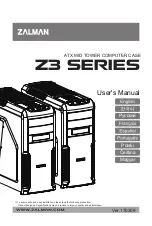
- 2 -
SYSTEM SET-UP
The DT-6360STC package contains two PIR mirror assemblies:
one for ceilings from 8' (2.4m) to 11' (3.3m) high, another for ceilings
from 12' (3.65m) to 16' (4.8m) high. The unit is shipped with the
8'-11' (2.4m-3.3m) mirror installed.
To change the mirror assembly, remove the front cover and turn it
over. Next, remove the protective cap and existing mirror assembly
by depressing the four retaining latches at their sides. Store (or
discard) the existing mirror and install the new one. Snap the
protective cap back into place, then replace the front cover.
Changing the PIR Mirror Assembly
PIR Masking
To eliminate specific PIR zones from the pattern, mask corre-
sponding segments on the PIR mirror with the adhesive-backed
masking tape provided. Remember, segments to be masked
will be on the side of the mirror OPPOSITE the unwanted zones.
See Figure 4.
Once the tape has been applied, walk-test the sensor to ensure
that the correct mirror segments have been masked.
PIR MASKING
MATERIAL
PLACED HERE
WILL BLOCK ZONES
HITTING HERE
Figure 4
Masking the PIR Mirrors
1
SYSTEM TESTING
DT-6360STC sensors are equipped with two diagnostic LEDs:
green for PIR and yellow for microwave. The red LED is used to
indicate an alarm condition.
Apply power to the sensor and wait until self-test is completed (90
seconds). Begin walk-testing after all three LEDs have gone out.
Figure 5
DT-6360STC PCB
2
EOL = End-of-Line (spare) terminal.
The Trouble Output is activated when a self-test failure or an INFORMER
®
condition occurs.
Refer to THE INFORMER CIRCUIT and the TROUBLESHOOTING sections.
Observing the proper polarity, wire the sensor as shown below
(use 22 to 14 AWG).
Note: Reverse polarity will not damage the unit.
WIRING
NC COM
NO
V-
TAMPER SWITCH
Normally Closed
(NC) with cover on
25 mA, 30 VDC.
1
2
2
EOL
TBL
EOL
CMD
REMOTE LED ENABLE or
COMMAND INPUT
(Self-Test Initiate) Active
Low 0 to 1.5 V Inactive
High 6 to V+ Input
Impedance 110 Kohms
(minimum).
OPEN COLLECTOR
TROUBLE OUTPUT
Vce .3V max @ 50
mA. 1K series
protection resistor.
1
Figure 3
Wiring
Diagram
ALARM RELAY
125 mA, 25 VDC. 22 ohm
series protection resistor.
POWER
At 12 VDC,
typically
40 mA;
maximum
50 mA
Note: Do not leave excess wire inside the unit. Push as much wire as
possible into the ceiling when returning the PCB to its housing.
Note: For proper wiring methods, refer to National Electrical Code NFPA 70.
Removing Front Cover After Installation (flush mount)
After installing and walk-testing the DT-6360STC flush mount, you
may need to make adjustments. Use a screwdriver to reopen the
front cover.
Insert the screwdriver as far as it will go in the grooves inside the
recess bucket. Gently press outward to release the latches holding
the front cover in place.
DT-6360STC sensors are equipped with a microwave range
thumbwheel (R32) for range adjustment. (Refer to Figure 5.)
Set the range at MINIMUM by turning the thumbwheel all the
way to the left.
As you perform the walk-test, gradually turn the thumbwheel to
the right to increase the microwave sensitivity until the desired
ranged is obtained.
Microwave Range Adjustment
Walk-test
Walk across the protected area at the ranges to be covered.
Two to four normal steps make the diagnostic LEDs light, and
the red LED should indicate an alarm condition. When there is
no motion in the protected area, all three LEDs should be off.
COMMAND INPUT / REMOTE LED ENABLE
Position W4 determines what function the Command Input
(CMD) terminal will provide.
Installing a jumper at position W4 makes the CMD terminal
function as a Remote LED Enable terminal. If the signal to the
Remote LED Enable terminal is low, the LEDs are enabled. If
the signal to the terminal is high, the LEDs are disabled. How-
ever, if a self-test error occurs, the LEDs will light regardless of
the state of the signal.
The CMD terminal functions as a Command Input terminal when
the jumper is removed from position W4. A momentary low
signal to the terminal (at least .5 seconds) will initiate the self-
test.
LED DISABLE (Local)
To disable the diagnostic LEDs and alarm LED, remove the
jumper from position W2 on the PCB. (See Figure 5.)
* If Self-Test fails or an INFORMER condition occurs, LEDs indicates nature of problem (see Tables 1,2 & 3)
ALARM & DIAGNOSTIC LEDs:
Yellow - During normal operation LED flashes ON when a MICROWAVE event is detected.*
Green - During normal operation LED flashes ON when a PIR event is detected.* (PIR Zone Finder)
Red - During normal operation LED illuminates when an ALARM condition is triggered.*
REMOTE LED ENABLE
or COMMAND INPUT
Jumper W4 installed:
CMD terminal functions
as Remote LED Enable.
Jumper W4 removed:
CMD terminal functions
as Command Input.
(Set to Command Input
at factory)
INSTALLER INITIATED
SELF-TEST
MOMENTARY SHORT
INSTALL JUMPER W3
TO DISABLE TROUBLE
OUTPUT WHEN AN
INFORMER CONDITION
OCCURS
(jumper is
factory installed)
W2
REMOVE JUMPER
W2 TO DISABLE
DIAGNOSTIC LEDS
AND ALARM LED
(jumper is factory
installed)
RED
GREEN
YELLOW
PLACE JUMPER W1
TO DETERMINE PIR
SENSITIVITY
(jumper set to
normal at factory;
see page 3)
MICROWAVE RANGE
THUMBWHEEL R32
(set to
maximum at factory)
TOP
BOTTOM
TAMPER SWITCH
MAX
R32
W4
W3
W1
V +
























